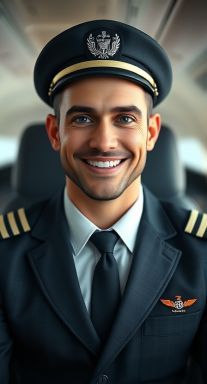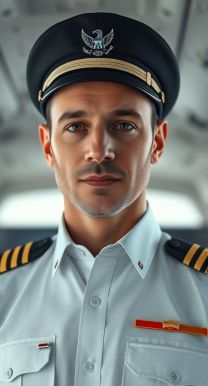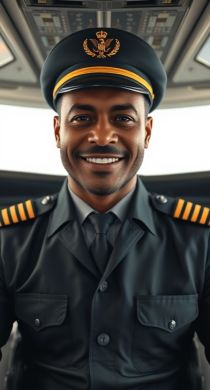Sound Module
Sound Module

General
The sound module of ACVacars delivers automized spoken out comments, warnings, checklists, etc., similar to the callouts of a true pilot monitoring next to the pilot flying during the different flight phases. For example, if you fly all of a sudden with a critical bank angle, the pilot monitor will tell you immediately ("Captain! Watch your bank angle!"). Whenever a flight engineer or even a navigator is on board, these flight crew members speak out specified comments, warnings, checklist-parts, etc., suitable to their flight crew role.
Different aspects of the sound module can be activated or deactivated by the user (see also Program Settings#Tab "Sound").
The AI voices have been created with https://elevenlabs.io/. The avatars have been created with https://deepai.org/machine-learning-model/3d-character-generator.
Each pilot AI character can deal with all roles of a flight:
- First Officer (FO)
- Flight Engineer (FE)
- Navigator (Nav)
- Freighter mechanic (Mec, not yet implemented)
- Cargo loadmaster (LMa, not yet implemented)
At the beginning of each flight, the flight crew roles are randomly filled with the pilot AI characters below. This means that on one flight, Rey might be your first officer, and on the next flight, Rey could be your flight engineer or navigator, with Dennis or someone else as the first officer instead.
It is planned to have six pilot AI characters at the end, also capable to randomly fill the roles of a freighter mechanic and of a cargo loadmaster.

Automized checklists, how the trigger-mechanism works
Each of the below listed automized checklists is activated after certain criteria (settings and flight situations) are met. The triggering criteria are confirmed by the co-pilot/flight crew with the word "Check" at the end of each line and are marked in bold style below. A line without the word "Check" at the end indicates that this checklist item is simply being spoken out but not being cross-checked with the actual settings inside the cockpit. Use the latter as an opportunity to manually cross-check your current settings with the stated ones. This simplification of concept must be taken into account due to interface limitations of FSUIPC/XPUIPC and/or due to the specific aircraft add-on.
Lets take as example the After-Takeoff-Checklist:
- First, you apply all the settings which are required to fullfil the after takeoff phase.
- After, having all the required settings applied, the automized After-Takeoff-Checklist sound is being played.
- Meaning: As soon as you hear the After-Takeoff-Checklist sound, you know that the required settings during this flight phase have been applied (=> automized retrospective verification, leading to a fluent interactive flight experience).
Used AI Characters
More AI voices will be implemented with further releases.
Alice
- The fairy godmother of the program ACVacars.

Rey
- A young guy, full of motivation and energy, a clear voice.
- Recently married (Barbara).
- Father of a young boy (Gabriel).
- Loves pilot jokes.
- Special taste of humour.
- Fast speaking, won't take long for a checklist.
- Likes to talk about drinking & eating, hotel accommodations and private life.

Will
- Senior attitude, clear and encouraging voice.
- Married (Susanne), father of two teenage girls (Debbi, Judy).
- Tells only seldom a joke, humour is less his business.
- Calm speaking, giving more time to crosscheck any checklist reading.
- Likes to talk about his family.
- Talks sometimes about the advantages of a "nine to five" job, but he truly loves flying nevertheless.

Dennis
- Very experienced, "never give up" attitude.
- Family man, married (Amelia), his two sons (Jamal, Deon) and his daughter (Zola) keep him busy.
- His wife Amelia must possess a strong and respectable personality, Dennis talks here and there about her.
- Talks each flight about his passion: Fishing and fine fish meals.
- Had bad experiences with the healthcare system. He gets through it by telling doctor jokes.

George
- An old freight dog, nothing to proof anymore.
- Calm, serious voice.
- Divorced (ex-wife Marianne), not talking much about private life stuff (daughter Roxanne).
- Suffering since his divorce, financially and mentally. Telling advocate jokes sometimes.
- Flying is everything in his life.
- The aircraft is breaking apart? George will land it anyway. Without a single drop of sweat.
- Not in the mood to laugh about jokes.
- Sometimes, sarcasm is flickering up.
In general, the indications, warnings and comments are being given by the first officer (FO).
But, if a flight engineer (FE) is on board, the FE will comment/talk on:
- Cabin lights
- Engines
- Boarding/Deboarding and door indications
- Fuelload status reports
- Airport direction indications (not added yet)
- Parking brake warnings
- Reverser warnings
- Engines warnings
- Gross-weight/payload warnings
- Punctuality warnings
- Distance indications
- Top of climb (TOC) and top of descent (TOD) indications
- Approaching indications
- Airport direction indications (not added yet)
- TOC warning
- Arrival airport location warning
- Going through checklist-sections containing FE tasks.
If a navigator is even part of the cockpit crew (e.g. An-225), he will comment on:
- Distance indications
- Top of climb (TOC) and top of descent (TOD) indications
- Approaching indications
- Airport direction indications (not added yet)
- TOC warning
- Arrival airport location warning
- Going through checklist-sections containing Nav tasks. (not added yet)
Sounds - Program voices (Alice)
- ACVacars startup, "Welcome" message
- MSFS, instructions, how to deal with certain jam situations of MSFS when starting-up an ACV flight (either menu mode or hidden (active) pause mode)
- MSFS, instructions, how to deal with the payload and fuelload capabilities when using ACVacars via Fsuipc.
- Information about a foreseeable economic loss while preparing an ACV flight.
- Information about a mismatch in startup time and pushback time of more than 23 hours (wrong day selected).
- Information about a mismatch in startup time and pushback time of more than 45 minutes (not meeting the start-flight time spot).
- Information about not having enough time until PB for a serious flight preparation (if less than 20min before PB time).
- Information about a non meaningful fuelload during the cockpit preparation phase.
- Information about a non sufficient payload during the cockpit preparation phase.
- Information about a non meaningful setting of the parking brake/beacon lights during boarding phase.
- Information about a gross-weight excess when loading an ACV flight (corrupt pre-settings).
Sounds - Crew voices - Systems
The interaction of the user (as pilot) with the following aircraft systems will be commented on by the cockpit crew.
- Aileron full left/right
- Autopilot master ON/OFF
- Autothrottle ON/OFF
- Elevator full up/down
- Engine 1 to 6, running
- First engine spooling up
- Flaps 1 to 50 degrees, retracted, down, up, full
- Landing-gear down/up
- Last engine shutting down
- Lights navigation, beacon, landing, strobe, taxi, logo ON/OFF
- Main door open/closed & locked
- Rudder full left/right
- Spoilers retracted/released/fully extended
Sounds - Crew voices - Flight phases
The following flight phases are being mentioned (only once per flight) by the cockpit crew:
- Boarding ongoing/interrupted
- Pushback
- Taxiing to takeoff, with loading-note hint
- Takeoff (acceleration), taking off (leaving ground)
- Climb phases (positive climb, main climb, climb further, initial TOC, passing FL100, FL180, FL270)
- Distance phases (50% distance; 1000nm, 700nm, 500nm, 200nm to arrival airport; reaching top of distance TOD)
- Descent phases (passing TOD, main descent, descending FL180, FL100, approaching arrival airport)
- Fuelload status report at 75%, 50%, 35%, 25%, 15%, 10%, 5%, 3%
- Taxiing to final position
- Deboarding/Paperwork
- Commenting on the touch-down vertical-speed
- Commenting on the overall flight performance
Sounds - Crew voices - Warnings
The following warnings are (repeatedly) spoken out by the co-pilot or by other crew members in case of:
- Bank angle excess small/NoGo
- Baro setting mismatch
- Door still open, on ground/taking off
- Flaps not set
- Fuel low/very low
- Gross weight excess while taking off
- Landing with baro mismatch
- Landing with forgotten landing gear
- Landing with not sufficient fuel reserve
- Landing at the incorrect arrival airport
- Lights forgotten to set or to switch it off (navigation, beacon, taxi, landing, strobe)
- Loosing engine 1 to 6, all
- Loosing all engines mid-air
- Maximum service ceiling exceeded
- Overspeed
- Parking brake activated when not standing still
- Parking brake still activated while increasing the engine thrust
- Reversers activated mid-air
- Reversers activated at low speed on the ground
- Speeding below FL100 small/NoGo
- Speeding with flaps not retracted small/NoGo
- Speeding with landing gear not retracted small/NoGo
- Spoilers not fully retracted while take-off or short before touch-down
- Stalling
- Taxiing with gross-weight excess
- Top of descent (TOD) never reached
- Touch-down with autopilot still ON but sufficient visibility
- Touch-down with excessive pitch
- Touch-down with too much tail wind
- Unpunctual departure
- Wearing the engines too much
Sounds - Crew voices - Checklists
Cockpit preparation checklist
Flight-situation: 1) Aircraft stands still on the ground without any speed and engines running, 2) 09 minutes or less to pushback-time and 3) no other flight phases have been triggered already.
- Parking brakes ON - Check;
- Landing gear DOWN, lights green - Check;
- Engines OFF - Check;
- Throttle lever IDLE - Check;
- Flaps retracted - Check;
- Spoilers retracted - Check;
- Navigation lights ON - Check;
- Logo lights - as desired;
- Emergency exit - ARMED;
- Autopilot master OFF - Check;
- Walkaround - completed;
- ATC flight clearance - WILCO;
- Transponder - ON and SET;
- Electricity - SET;
- Fuel load - considered;
- Payload completed - Check;
- Pressurization - PRESET;
- Warning-system-checks - completed;
Before pushback and startup checklist
Flight-situation: 1) Aircraft stands still on the ground with no engines running, 2) 06 minutes or less to pushback-time and 3) after passing the cockpit preparation checklist.
- Chocks - considered;
- Throttle lever IDLE - Check;
- Baro reference - SET;
- All Navigation systems - ALIGNED;
- ATC pushback and startup clearance - WILCO;
- Fuel tanks - SET;
- Fuel pumps - SET;
- APU master - ON;
- APU generator - ON;
- APU bleed air - ON;
- Ignition mode - SET;
- Packs - OFF;
After startup checklist
Flight-situation: 1) Aircraft stands still on the ground with all engines running and 2) after passing the cockpit preparation checklist.
- Beacon lights ON - Check;
- Engines up and running - Check;
- Fuel flow values - Check;
- Electricity generators ON - considered;
- Hydraulic systems - activated;
- Air condition system - SET;
- Pressurization system - SET;
- APU bleed air - OFF;
- APU generator - OFF;
- APU master - OFF;
- Packs - SET;
Before taxi checklist
Flight-situation: 1) Aircraft stands still on the ground ready to taxi, 2) all engines are running and 3) after passing the cockpit preparation checklist.
- All three rudders - Check; (aileron, elevator, rudder)
- Flaps set for takeoff - Check;
- Taxi lights ON - Check;
- Speed bugs - SET;
- ATC taxi clearance - WILCO;
Before takeoff checklist
Flight-situation: Aircraft is on the ground with all engines runnind and has passed the foregoing checklists.
- Landing lights ON - Check;
- Strobe lights ON - Check;
- Taxi lights OFF - Check;
- Packs - OFF;
- Flaps SET - Check;
- Speedbrakes retracted/ARMED - Check;
- TCAS - ON;
- Speedbugs - SET;
- ATC departure clearance - WILCO;
After takeoff checklist
Flight-situation: 1) Aircraft has taken off (leaving ground) and 2) has passed the foregoing checklists.
- Landing gear up - Check;
- Flaps adjusted - Check;
- Speed restriction - Check;
- Packs - ON;
Passing 10'000 ft checklist
Flight-situation: 1) Aircraft climbs and 2) is passing FL100.
- Speed restriction - passed;
- Flaps - considered;
- Landing lights - OFF;
- Anti-ice - considered;
- Pressurization system - verified;
Passing 18'000 ft checklist
Flight-situation: Aircraft climbs and is passing FL180.
- Baro reference - set to STANDARD;
- Anti-ice - considered;
- Fuel temperature and heating - verified;
- Cabin pressure - verified;
Cruise level checklist
Flight-situation: 1) Aircraft cruises and 2) is approaching the initial top of climb (TOC) point.
- Anti-ice - verified;
- Fuel temperature and heating - verified;
- Cabin pressure - verified;
- Air condition system - SET;
- Logo lights - as desired;
- Fuel status - verified;
Approaching top of descent (TOD) checklist
Flight-situation: Approaching TOD, close enough to the arrival airport.
- Fuel heating - considered;
- Anti ice settings - considered;
- Logo lights - as desired;
- NAV ILS frequency - SET;
- NAV ILS course - SET;
- ATC descent clearance - WILCO;
Descending 18'000 ft checklist
Flight-situation: Passing FL180 with a clear negative sink rate.
- Baro reference - SET;
- Anti-ice - verified;
Descending 10'000 ft checklist
Flight-situation: Passing FL100 with a clear negative sink rate.
- Landing lights ON - Check;
- Speed restrictions - Speed below 250 knots - Check;
- Speedbugs - adjusted;
- Flaps setting - considered;
- Auto brakes - considered;
Before landing checklist
Flight-situation: 1) Below 3000 ft, 2) a clear sink rate and 3) less than 20nm to arrival airport.
- Flaps for landing - Check;
- Landing gear down - Check;
- Speedbrakes retracted/ARMED - Check;
- Auto brakes - considered;
- Speedbugs - adjusted;
- Autopilot - considered;
- TCAS - adjusted;
- ATC landing clearance - WILCO;
After landing checklist
Flight-situation: 1) Aircraft on the ground, 2) taxi speed and 3) at the arrival airport.
- Taxi lights ON - Check;
- Landing lights OFF - Check;
- Strobe lights OFF - Check;
- Logo lights - as desired;
- Flaps retracted - Check;
- Spoilers retracted - Check;
- Autopilot master OFF - Check;
- Autobrakes OFF - considered;
- Radar OFF - verified;
- TCAS OFF - considered;
- ATC taxi clearance - WILCO.
Taxi checklist
Flight-situation: 1) Aircraft on the ground, 2) taxi speed and 3) at the arrival airport.
- Not exceeding taxi speed limit - Check;
- Logo lights - as desired;
- ATC, gate or parking position - WILCO.
- APU master ON - considered;
- APU generator and bleed air - considered;
After parking checklist
Flight-situation: 1) Aircraft stands still on the ground, 2) deboarding phase ongoing and 3) at the arrival airport.
- Parking brakes ON - Check;
- Taxi lights OFF - Check;
- Fuel flow switches - ALL CUTOFF - Check;
- Navigation lights OFF - Check;
- Beacon lights OFF - Check;
- Logo lights - as desired;
- Transponder - OFF;
- External power - connected and activated;
- Fuel pumps - OFF;
- Wheel chocks - considered;
- Main door open - Check;